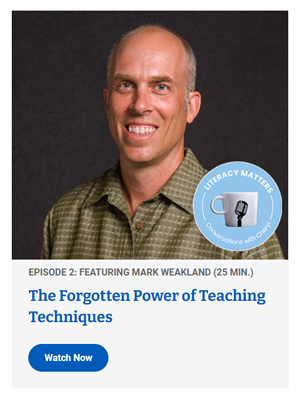Did you know that you have secret superpowers that can enhance the way your students learn? Come hear what literacy consultant and educator Mark Weakland can share about helping you tap into this power.
On this week’s episode of Literacy Matters with Cheryl Lundy Swift, Mark joins us to explore a variety of useful in-the-moment techniques that you can use in your phonics and reading instruction. Learn about the subtle instructional gestures and teaching practices you have at your disposal to truly be the literacy hero your students deserve.
“Let those techniques become our teaching habits.” – Mark Weakland
Switch it up.
All students are unique. What might work seamlessly on one day might be a total dud on the following day. That’s completely okay! Your classroom instruction can benefit from keeping things fresh on a day-to-day basis. For example, try alternating between whole group and small group readings to prevent your instruction from getting stale.
Use explicit instruction during early developmental stages.
You might be tempted to give your students some exploratory wiggle room throughout your lessons. During early stages that involve spelling, phonics, and vocabulary instruction, Mark recommends taking a direct, explicit approach. Instead of letting students think about how to spell certain sounds, show them! This will give students a solid foundation for future lessons that involve more complex mechanics.
Be descriptive with your positive reinforcement.
We have all heard the usual “good job!” and “great work!” lines after completing tasks. And while these are all good and fine, your students can benefit far more from descriptive reinforcement.
For example, “Good job, I see that you looked at the letters in the word instead of just the beginning and end” works far better as positive reinforcement than the previous statements. Take a couple of extra seconds to acknowledge and reinforce the particulars of what students are doing correctly.
Give students time to think.
This is where the exploratory approach comes in. Once you feel that students have grasped the basic principles of your lesson, start asking questions while allowing time for your students to think about other possible answers.
“Don’t raise your hand. Just think in your head for 3 minutes.” Incorporating this technique allows high-flyer students to flex their creative muscles and explore alternate possibilities.
At the end of the day, ensuring your students are engaged and actively participating is the key. Whether you rely on direct instruction or implementing alternate approaches to reading, keep it fresh and keep it fun!
Learning Without Tears is committed to helping you become the literacy heroes your students need. By partnering with experts in the field, Literacy Matters is diving deep to explore the tips, tricks, and resources that make a world of difference in and out of the classroom. To find out some other superpowers you can tap into, watch the full episode of Literacy Matters with Mark Weakland.
